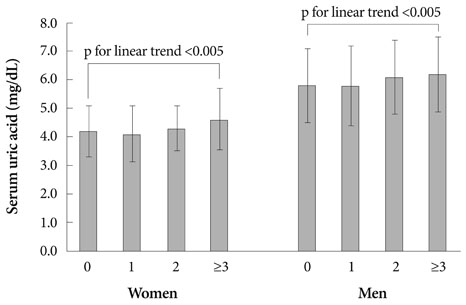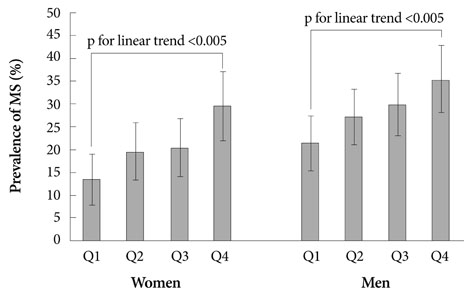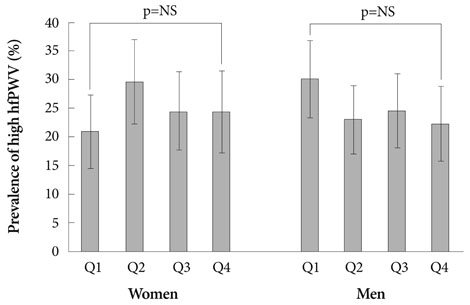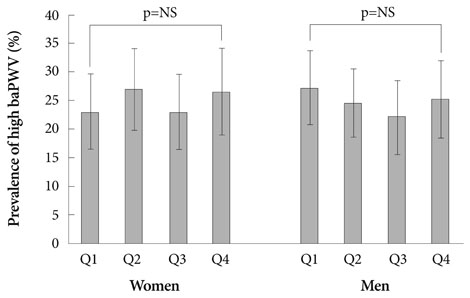Korean Circ J.
2010 Jul;40(7):314-320. 10.4070/kcj.2010.40.7.314.
Relationship Between Serum Uric Acid Levels, Metabolic Syndrome, and Arterial Stiffness in Korean
- Affiliations
-
- 1Department of Internal Medicine, Dongguk University College of Medicine, Ilsan Hospital, Goyang, Korea. ykkim@duih.org
- 2Department of Emergency Medicine and Cardiology, Seoul National University College of Medicine, Seoul, Korea.
- KMID: 2225174
- DOI: http://doi.org/10.4070/kcj.2010.40.7.314
Abstract
- BACKGROUND AND OBJECTIVES
Associations have been reported between the serum uric acid (SUA) level, metabolic syndrome (MS), and atherosclerosis. We have determined the relationship between the SUA level, MS, and arterial stiffness in Korean.
SUBJECTS AND METHODS
Cross-sectional data from 1,276 adults who underwent routine laboratory tests and pulse wave velocity (PWV) measurements during a health check-up were analyzed in a gender-specific manner. None of the participants had atherosclerotic cardiovascular disease, diabetes, renal disease, or systemic disease, or were under treatment which would affect SUA levels, or taking medications for hypertension or dyslipidemia.
RESULTS
After adjustment for age, smoking status, total cholesterol (TC), and creatinine, the odds ratios (ORs, 95% confidence interval) of gender-specific quartiles of SUA for MS were 1.0, 1.28 (0.66-2.47), 1.46 (0.76-2.82), and 2.21 (1.15-4.26) in females, and 1.0, 1.33 (0.82-2.17), 1.60 (0.96-2.66), and 2.03 (1.21-3.40) in males. However, after adjustment for waist circumference, there were no significant differences in the ORs among the SUA quartile groups in females and males (both, p=NS). The Pearson's correlation coefficients for the relationship between SUA levels and heart-femoral (hf) PWVs or brachial-ankle (ba) PWVs were not significant in females and males (r=0.054 and r=0.015, respectively, in females; r=-0.036 and r=-0.015, respectively, in males; all, p=NS).
CONCLUSION
An elevated SUA level is associated with abdominal obesity among the MS components, but the SUA level is not associated with PWV in females or males.
Keyword
MeSH Terms
Figure
Reference
-
1. Yoo TW, Sung KC, Shin HS, et al. Relationship between serum uric acid concentration and insulin resistance and metabolic syndrome. Circ J. 2005. 69:928–933.2. Choi HK, Ford ES. Prevalence of the metabolic syndrome in individuals with hyperuricemia. Am J Med. 2007. 120:442–447.3. Ishizaka N, Ishizaka Y, Toda E, Nagai R, Yamakodo M. Association between serum uric acid, metabolic syndrome, and carotid atherosclerosis in Japanese individuals. Arterioscler Thromb Vasc Biol. 2005. 25:1038–1044.4. Onat A, Uyarel H, Hergenc G, et al. Serum uric acid is a determinant of metabolic syndrome in a population-based study. Am J Hypertens. 2006. 19:1055–1062.5. Klein BE, Klein R, Lee KE. Components of the metabolic syndrome and risk of cardiovascular disease and diabetes in Beaver Dam. Diabetes Care. 2002. 25:1790–1794.6. Lin SD, Tsai DH, Hsu SR. Association between serum uric acid levels and components of the metabolic syndrome. J Chin Med Assoc. 2006. 69:512–516.7. Rathmann W, Funkhouser E, Dyer AR, Roseman JM. Relations of hyperuricemia with the various components of the insulin resistance syndrome in young black and white adults: the CARDIA study. Ann Epidemiol. 1998. 8:250–261.8. Grundy SM, Cleeman JI, Daniels SR, et al. Diagnosis and management of the metabolic syndrome: an American Heart Association/National Heart, Lung, and Blood Institute Scientific Statement. Circulation. 2005. 112:2735–2752.9. Reimann M, Schutte AE, Malan L, Huisman HW, Malan NT. Hyperuricema is an independent risk factor for the metabolic syndrome in a sub-Saharan African population: a factor analysis. Atherosclerosis. 2008. 197:638–645.10. Bengtsson C, Lapidus L, Stendahl C, Waldenström J. Hyperuricemia and risk of cardiovascular disease and overall death: a 12-year follow-up of participants in the population study of women in Gothenburg, Sweden. Acta Med Scand. 1988. 224:549–555.11. Freedman DS, Williamson DF, Gunter EW, Byers T. Relation of serum uric acid to mortality and ischemic heart disease. The NHANES I Epidemiologic Follow-up Study. Am J Epidemiol. 1995. 141:637–644.12. Niskanen LK, Laaksonen DE, Nyyssonen K, et al. Uric acid level as a risk factor for cardiovascular and all-cause mortality in middles-aged men: a prospective cohort study. Arch Intern Med. 2004. 164:1546–1551.13. Santos RD, Dasir K, Orakzai R, Meneghelo RS, Carvalho JA, Blumenthal RS. Relation of uric acid levels to presence of coronary artery calcium detected by electron beam tomography in men free of symptomatic myocardial ischemia with versus without the metabolic syndrome. Am J Cardiol. 2007. 99:42–45.14. Kawamoto R, Tomita H, Oka Y, Ohtsuka N. Relationship between serum uric acid concentration, metabolic syndrome and carotid atherosclerosis. Intern Med. 2006. 45:605–614.15. Kim YK, Kim D. The relation of pulse wave velocity with Framingham risk score and SCORE risk score. Korean Circ J. 2005. 35:22–29.16. Na SH, Kim YS, Bae JH, et al. Effects of physical activity and aerobic exercise capacity on aortic stiffness in patients with untreated hypertension. Korean Circ J. 2009. 39:52–56.17. Tanaka H, Munakawa M, Kawano Y, et al. Comparison between carotid-femoral and brachial-ankle pulse wave velocity as measures of arterial stiffness. J Hypertens. 2009. 27:2022–2027.18. Jung AD, Kim W, Park SH, et al. The effect of telmisartan on endothelial function and arterial stiffness in patients with essential hypertension. Korean Circ J. 2009. 39:180–184.19. Lee SY, Park HS, Kim DJ, et al. Appropriate waist circumference cutoff points for central obesity in Korean adults. Diabetes Res Clin Pract. 2007. 75:72–80.20. Takahashi S, Yamamoto T, Tsutsuni Z, Moriwaki Y, Yamakita J, Higashino K. Close correlation between visceral fat accumulation and uric acid metabolism in healthy men. Metabolism. 1997. 46:1162–1165.21. Ryu S, Song J, Choi BY, et al. Incidence and risk factors for metabolic syndrome in Korean male workers, ages 30 to 39. Ann Epidemiol. 2007. 17:245–252.22. Sui X, Church TS, Meriwether RA, Lobelo F, Blair SN. Uric acid and the development of metabolic syndrome in women and men. Metabolism. 2008. 57:845–852.23. Coutinho Tde A, Turner ST, Peyser PA, Bielak LF, Sheedy PF 2nd, Kullo IJ. Associations of serum uric acid with markers of inflammation, metabolic syndrome and subclinical coronary atherosclerosis. Am J Hypertens. 2007. 20:83–89.24. Tavil Y, Kaya MG, Oktar SÖ, et al. Uric acid level and its association with carotid intima-media thickness in patients with hypertension. Atherosclerosis. 2008. 197:159–163.25. Iribarren C, Folsom AR, Eckfeldt JH, McGovern PG, Nieto FJ. Correlates of uric acid and its association with asymptomatic carotid atherosclerosis: the ARIC study. Ann Epidemiol. 1996. 6:331–340.26. Ishizaka N, Ishizaka Y, Toda EI, Hashimoto H, Nagai R, Yamakado M. Higher serum uric acid is associated with increased arterial stiffness in Japanese individuals. Atherosclerosis. 2007. 192:131–137.27. Saijo Y, Utsugi M, Yoshioka E, et al. Relationships of C-reactive protein, uric acid, and glomerular filtration rate to arterial stiffness in Japanese subjects. J Hum Hypertens. 2005. 19:907–913.28. Kimoto E, Shoji T, Shinohara K, et al. Preferential stiffening of central over peripheral arteries in type 2 diabetes. Diabetes. 2003. 52:448–452.29. Tomiyama H, Yamashina A, Arai T, et al. Influence of age and gender on the results of noninvasive brachial-ankle pulse wave velocity measurement-a survey of 12517 subjects. Atherosclerosis. 2003. 166:303–309.30. Cuspidi C, Valero C, Sala C, et al. Lack of association between serum uric acid and organ damage in a never-treated essential hypertensive population at low prevalence of hyperuricemia. Am J Hypertens. 2007. 20:678–685.
- Full Text Links
- Actions
-
Cited
- CITED
-
- Close
- Share
- Similar articles
-
- Four-Year Change of Metabolic Syndrome Incidence According to Serum Uric Acid
- Relationship between Serum Uric Acid and Metabolic Syndrome
- The impact of uric acid and metabolic syndrome on the incidence of hypertention in a Korean population
- Interrelationship of Uric Acid, Gout, and Metabolic Syndrome: Focus on Hypertension, Cardiovascular Disease, and Insulin Resistance
- Association between Serum Uric Acid and Metabolic Syndrome in Koreans





